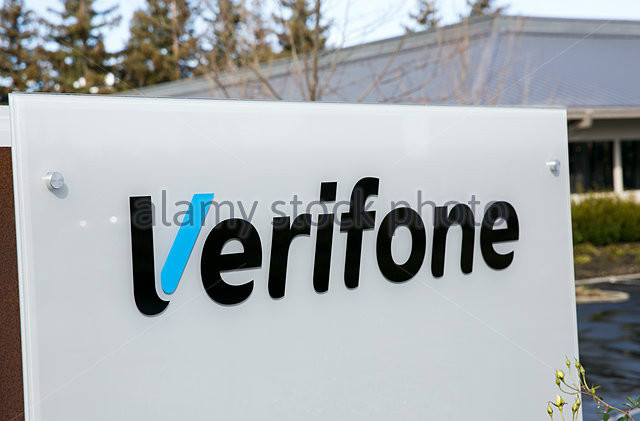
Verifone; 湾区高科技公司; 89/100
Verifone is an American multinational corporation headquartered in San Jose, California that provides technology for electronic payment transactions and value-added services at the point-of-sale.
Verifone sells merchant-operated, consumer-facing and self-service payment systems to the financial, retail, hospitality, petroleum, government and healthcare industries. The company’s system solutions consist of POS electronic payment devices that run its own operating systems, security and encryption software, and certified payment software, and that are designed for both consumer-facing and unattended environments.
Its system solutions process a range of payment types, including signature and personal identification number (PIN)-based debit cards, credit cards, contactless/radio frequency identification cards, smart cards, pre-paid gift and other stored-value cards, electronic bill payment, check authorization and conversion, signature capture and Electronic Benefit Transfer (EBT).
The company’s architecture enables multiple applications, including third-party applications, such as gift card[11] and loyalty card programs, healthcare insurance eligibility, and time and attendance tracking, and allows these services to reside on the same system without requiring re certification upon the addition of new applications.
Overview
The company uses the Verifone name and logo worldwide as a primary part of the branding of the company and its products, and registers these trademarks in the key jurisdictions where the company does business, including the U.S. and the EU. As of October 31, 2013, the company held trademark registration in 22 jurisdictions (including registration in the EU that covers various country level registrations that the company had previously filed) for the ‘VERIFONE’ trademark and in 32 jurisdictions (including registration in the EU that covers various country level registrations that the company had previously filed) for ‘VERIFONE’ trademark, including its ribbon logo. On November 3, 2014, The company unveiled a new corporate logo, new brand identity that represents a new Verifone that is driving the future of commerce in a rapidly evolving digital world where electronic payments, commerce and mobility are converging.[12][13] From its beginnings as the first payment device manufacturer, Verifone’s product and point-of-sale service offerings have changed considerably.[14] Verifone offer payment technology expertise, solutions and services that add value to the point of sale with merchant-operated, consumer-facing and self-service POS payment systems.
Founded in Hawaii, U.S. in 1981, Verifone now operates in more than 150 countries worldwide and employ nearly 5,000 people globally. Verifone’s steady growth has come both organically through a dedication to innovation and strategic partnerships,[15] and from smart acquisitions.[16] Core focus and growth areas for the company includ e mobile commerce,[17][18][19] security, services and emerging global markets.
As a global company, Verifone have headquarters representing each of its core global areas of operation: San Jose, California; London, U.K.; Singapore; Turkey; and Miami, Florida. Verifone is dedicated to supporting local markets and needs with a direct presence in more than 45 countries.
History
Verifone was founded by William “Bill” Melton and incorporated in Hawaii in 1981, and named itself after its first product, the name standing for Verification telephone.
Since the late 1980s, Verifone has held more than 60 percent of the U.S. market, and during the 1990s the company captured more than half of the international market for such systems. In 1996, the company placed its five millionth system. Domestic and international sales of POS systems continue to form the majority of Verifone’s annual sales, which hit $387 million in 1995 and were expected to top $500 million in subsequent years.
The sudden growth of the Internet, and especially the World Wide Web, in the mid-1990s created a demand for secure online financial transaction applications. Verifone has taken the lead in designing applications conforming to the Secure Electronic Transaction (SET) standards developed by Visa Inc. and MasterCard. With the $28 million 1995 acquisition of Enterprise Integration Technologies,[20] the company that developed the Secure HyperText Transfer Protocol(S-HTTP), and a $4 million equity investment in CyberCash, Inc., led by Verifone founder William Melton, and with 1996 partnership agreements with Internet browser leaders Netscape, Oracle Corporation, and Microsoft, Verifone has rolled out a suite of software products targeted at consumers, merchants, and financial institutions allowing secure purchases and other transactions online. Purchases over the Internet, which still produced as little as $10 million in 1995, are expected to reach into the billions by the turn of the century. Verifone has also been working to marry the smart card to the Internet; in 1996, the company introduced the Personal ATM (P-ATM), a small smart card reader designed to be attached to the consumer’s home computer, which will enable the consumer not only to make purchases over the Internet, but also to “recharge” the value on the card. Verifone has also partnered with Key Tronic to incorporate a P-ATM interface directly into that company’s computer keyboards.
